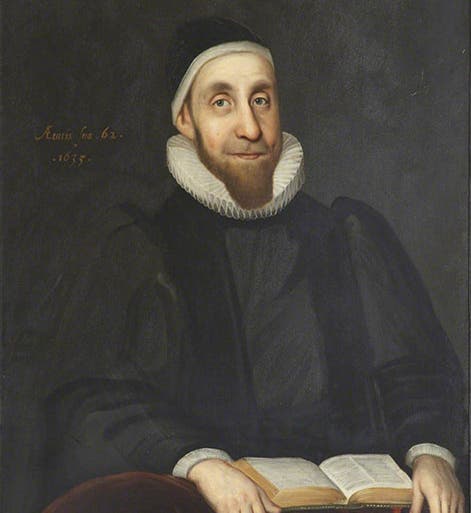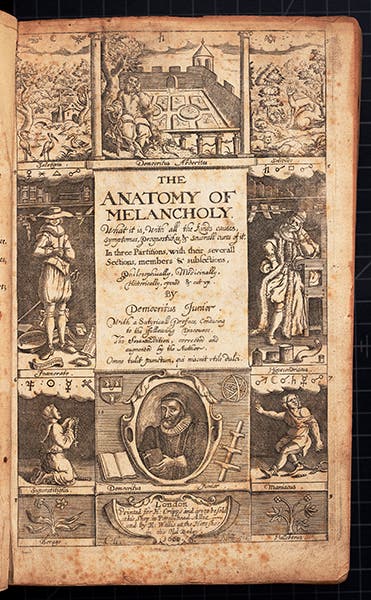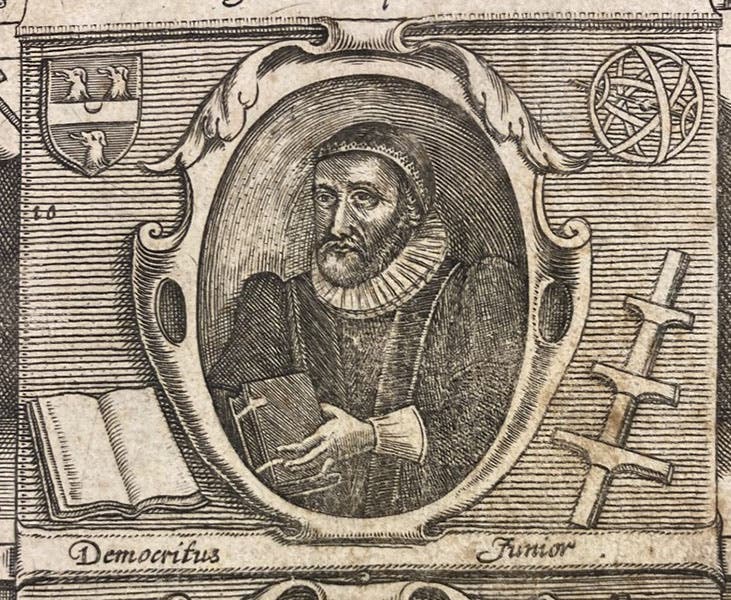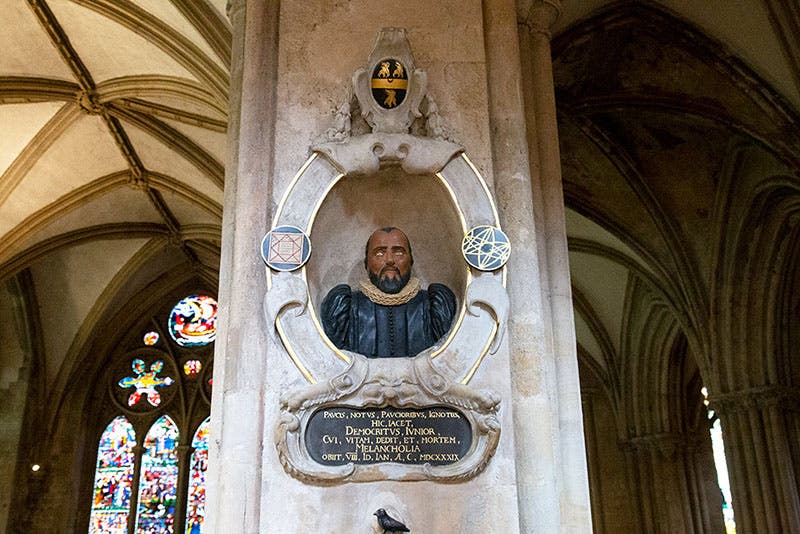Scientist of the Day - Robert Burton
Robert Burton, an English scholar, died Jan. 25, 1640, at age 63. Burton attended Brasenose College at Oxford, where he was a fellow for a while before switching to Christ Church, where he spent the rest of his life in residence. Burton was a book rat; he presided over the library at Christ Church and had access to the Bodleian Library, and he amassed his own considerable private library of some 1700 books. Burton read books all day long, all sorts of books, except theology, which he disliked intensely, an interesting stance from someone who was a cleric as well. In 1621, he published one of the true classics of English literature, The Anatomy of Melancholy. The title goes on for quite a bit further than the four words I give, as you can see if you glance at the title panel (third image) from the illustrated titlepage (second image), which first appeared in the 3rd edition of 1628. The book was a surprise best-seller, going through 5 editions in Burton’s lifetime, and quite a few more thereafter.
The ostensible purpose of his book was to examine the causes and cure of melancholia, a syndrome that seemed to afflict much of the population of England at the time, and which stemmed from an excess of the humor melancholy, or black bile. Burton suffered from melancholia himself, so in a way, writing this book was a form of therapy. It is Burton’s manner of writing that is so remarkable – the book is a continuous stream of snippets from hundreds of authors, interlarded with Burton's own interpretations and insights, and with margins on both sides filled with source notes. He had read all the medical authors, Galen and Avicenna and such, since he was grappling with a medical topic, but he was fully conversant with Cicero and Horace, Aristophanes and Augustine, Erasmus and Calvin, and even Copernicus and Galileo, and you will encounter snippets from all of them throughout his book.
This sounds so far like a book you might not want to tangle with, especially if you have doubts about the value of scholarship that is worn on one's sleeve. But Burton will surprise you, should you give him a chance, for he also took aim at the foibles of English society, especially those rooted in British class structure. He wrote under the pen name of “Democritus Junior,” adopting the persona of the Greek philosopher Democritus who, when not proposing the atomic theory, spent considerable time laughing at the idiotic behavior of the human animal, so much so that he earned the sobriquet, “the Laughing Philosopher." Burton liked to laugh at the comedy of errors that was human nature, except when he got hopping mad, as he did when berating Puritanism, the Catholic Church, and war.
We have a copy of the 7th edition of The Anatomy of Melancholy (1660) in our History of Science Collection, which is a bit of a surprise, since such a book would not normally fall within our collection guidelines, but the purchase was made many years ago, and I am glad an exception was made in this case, since it is a delightful read, especially the 78 quarto-page introduction by "Democritus Junior." As a bonus, it includes the engraved title page, the source of three of our images.
I think I first encountered Burton when I read another masterpiece, this one modern, that also both exemplifies and lampoons scholarship. The book was On The Shoulders of Giants: A Shandean Postscript (1965), by Robert K. Merton. In the book, written in the form of a stream of daily letters to a fellow historian, Merton tries to run down the origins and permutation of a phrase penned by Isaac Newton in a letter to Robert Hooke: "If I have seen farther, it is by standing on the shoulders of giants." Merton begins his tale with Burton, since Burton used a version of the phrase – “A dwarf standing on the shoulders of a Giant, may see farther then the Giant himself” – at the very start of his introduction, in an attempt to justify his writing style of launching his own thoughts from atop a mass of quotations from other authors. Burton gave, as his source, Didacus Stella, "in Luc. 10, tom. 2", and Merton has great fun quoting later sources, like Bartlett’s Book of Quotations, that use exactly the same citation, a sure indication that no one has tried to find out just what "Luc. 10, tom. 2" refers to.
Burton was a special hero of Sir William Osler, the great humanist physician (and curator of the Bodleian Library, which acquired many of Burton’s books after his death). Osler wrote three essays praising Burton, which are usually merged into one, as in a chapter of The Selected Writings of Sir William Osler (1951), retitled A Way of Life in the paperback copy I hold. I confess I did not find many of Osler’s insights that quotable, until I came to the passage below, written in 1909, which sums up Burton in such a remarkable manner than I just had to include it all:
Burton had the misfortune, for us the good fortune, to have Saturn as lord of his geniture; and, fatally driven as he says upon the rock of melancholy, to ease his mind and comfort one sorrow with another, idleness with idleness, to make an antidote out of that which was the prime cause of his disease, he composed the Anatomy of Melancholy. Undertaken partly to do himself good, partly out of a fellow feeling for others, he spent his time and knowledge in laboriously collecting out of the vast chaos and confusion of books a cento [hotchpotch] for the consolation of the afflicted in spirit. That which others heard and read of he had felt and practised himself; they got their knowledge by books, he his by melancholizing.
Burton is a hero to modern-day Brasenose College, which has his portrait (first image); Christ Church Cathedral, which has his elaborate tomb (sixth image); the libraries of Christ Church and the Bodleian, which have his books; and scholars like myself, who wish we had his combination of erudition, ennui, indignation, and panache.
William B. Ashworth, Jr., Consultant for the History of Science, Linda Hall Library and Associate Professor emeritus, Department of History, University of Missouri-Kansas City. Comments or corrections are welcome; please direct to ashworthw@umkc.edu.











![Columbine, hand-colored woodcut, [Gart der Gesundheit], printed by Peter Schoeffer, Mainz, chap. 162, 1485 (Linda Hall Library)](https://assets-us-01.kc-usercontent.com:443/9dd25524-761a-000d-d79f-86a5086d4774/3829b99e-a030-4a36-8bdd-27295454c30c/gart1.jpg?w=210&h=210&auto=format&fit=crop)
